LEKT Natural Resources Fisheries staff climb over the guardrail along highway 101 above the culvert that allows Tumwater Creek to flow beneath it to the Strait of Juan de Fuca. The creek is nearly invisible from the road and they make their way down the steep banks to the narrow drainage, dropping gear on a cobble bar in the middle of a cool, clear and densely vegetated corner of the creek.
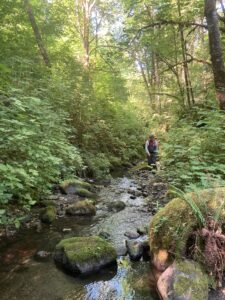
The pristine nature of Tumwater Creek’s reach below Highway 101 is surprising, given its close proximity to the congestion of the edge of town.
The purpose of this field visit is to survey the stream for Pacific lamprey, a primitive jawless fish that resemble eels due to their lack of paired fins or scales. Pacific lamprey are a lesser known anadromous species (meaning they migrate to the ocean from freshwater and back again through their life cycle) that, like salmon, contribute critical marine-derived nutrients into aquatic systems and have historically been an important food resource for animals and people. Justin Stapleton, biologist on the project, says they also reduce predation pressure on salmon because they’re fatty and nutritious.
LEKT biologists have been working since Elwha river dam removal to understand how and to what extent lamprey have re-colonized the watershed and connected habitats. This work will expand on the knowledge of where populations exist on unsurveyed streams, particularly in an area where according to the Pacific Lamprey Conservation Initiative, the overall population is critically imperiled.
Adult lamprey build nests in gravel using the suction capabilities of their jaws. When the eggs hatch, larval lamprey emerge as blind and resemble earthworms that burrow themselves in the sediment to filter feed and hide from predators, slowly drifting downstream as they grow. It can be several years before they metamorphose into their juvenile form when they develop eyes and teeth, finally making their way into the ocean where they will spend another two to five years as adults before returning to freshwater. Unlike salmon, adult lamprey do not necessarily return to their natal stream, but instead to any suitable spawning habitat, honing in on the pheromones produced by larval lamprey. In other words, the presence of these ‘ammocoetes’ indicates to LEKT biologists, as well as future adult lamprey, that some lamprey have recently found their way into the system and successfully spawned. The Tumwater survey yields only larval lamprey, but in great numbers, as well as several trout and even some wild Coho fry.
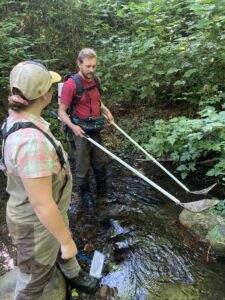
LEKT Fisheries biologist Justin Stapleton uses a lamprey- specific backpack electrofisher, which delivers a slow wave shock to encourage the fish out of the sediments into the water column, where Peninsula college student volunteer Bligh Hueske can catch them. The team samples along a 100 meter reach below the Highway 101 culvert and will later sample above it to determine fish passage.
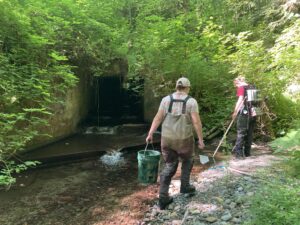
Although this lamprey survey is part of an independent project, this is not the only current effort focused on the several streams that run unassumingly throughout the city limits of Port Angeles, which all historically supported populations of salmonids. Now that fish are returning to the Elwha watershed, biologists and managers want to ensure further resilience by broadening their efforts to the peripheral systems that can act as refugia and also promote diversity among these populations.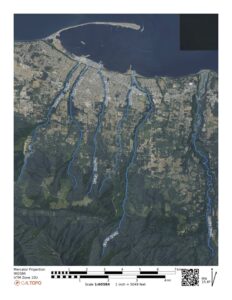
There are six major creek systems that run through the urban sprawl of Port Angeles, presenting several challenges for fish passage as well as abundant opportunities for collaborative restoration.
This Summer, LEKT Natural Resources staff have also conducted habitat and fish surveys on all of these creeks to understand the potential for each of these systems to recover from over a century of development. The act of restoring a stream such as White Creek that begins in the national park, but also runs through private forestry land, a community college, department of transportation infrastructure and several city neighborhoods is a complex and coordinated effort. Just gaining access to conduct a basic habitat reconnaissance on each of these reaches is a challenge. But built into this shared management of the system are great opportunities for collaboration with land-owners and the communities that live along them.
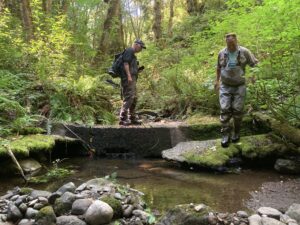
LEKT Habitat Manager Mike McHenry and contract biologist Jamie Michel assess an old road causeway built through White Creek just below the Peninsula College campus that has not only been leaching out harmful chemicals for decades, but limits fish passage especially during low flows. Further upstream, Mike examines a clogged and collapsing culvert beneath a private neighborhood access road, which presents similar challenges for fish.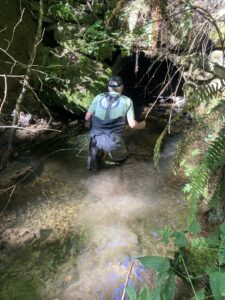
Although salmon are scarce, the extent of available habitat is promising. The team determines that White Creek is full of good wood to support pool formation and its banks are healthily vegetated, providing soil stability and critical shade. Fish could benefit immensely simply by removing large, toxic debris such as tires as well as repairing old infrastructure, such as collapsing culverts.
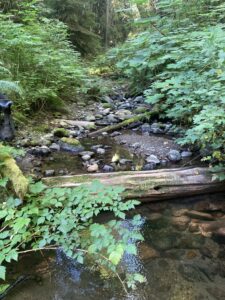
Natural log jams found in streams are not obstacles for fish, but vital components of a complex habitat structure that drive the formation of pools and influence the distribution of sediments for fish spawning. Or as Mike McHenry puts it simply: No wood, no water.
Justin tells me he was surprised not to find any lamprey in White Creek, nor in Ennis despite their presence and abundance in adjacent Morse Creek. Considering the differences in these two systems that may support or inhibit fish, it is notable that the lower reaches of both White and Ennis Creeks have culverts below Highway 101 whereas Morse Creek flows unimpeded below a highway bridge. Morse creek was also restored in 2010 by the North Olympic Salmon Coalition in partnership with LEKT, Jamestown S’Klallam Tribe, USFWS, Clallam County, Department of Ecology, Fish America, National Oceanic and Atmospheric Administration, Salmon Recovery Funding Board, Washington Wildlife and Recreation Program and National Association of Counties.
There are likely several factors influencing the presence, diversity and abundance of salmon in each of these unique streams. But given their historic hospitality to fish and the positive results of restored habitat for them in at least one of these urban reaches reinforces the value of furthering these efforts elsewhere. Over the next few years, LEKT Natural Resources staff hope to work with each stakeholder along all of these urban streams to steward their return to a healthy state.
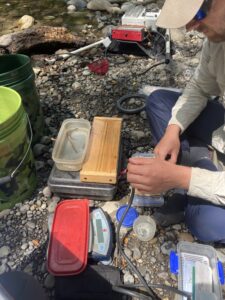
Justin measures and weighs larval lamprey, also known as ammocoetes, found on a restored section of Morse Creek.
Text and photos by Science Outreach Coordinator, Chelsea Behymer
